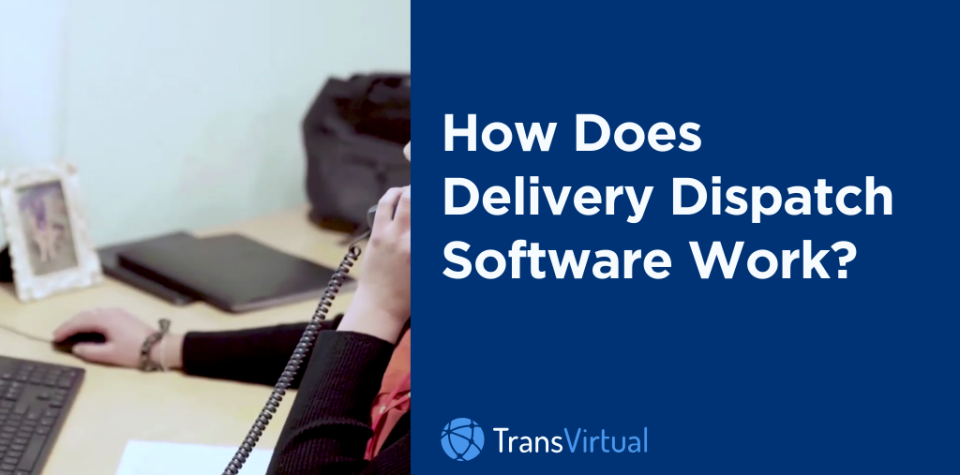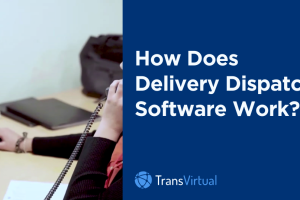Table of Contents
There’s no doubt about it, delivery management is complex and time consuming.
Your dispatch team needs to: optimise routes, provide customers with up-to-date ETAs, make changes when routes are in progress and manage customer expectations.
You can use several different platforms to manage these tasks. Maybe a route optimization tool to create fast and efficient delivery routes, and an ePOD app to collect and store proof of delivery.
But like most things, it’s more efficient and cost-effective to do it on unified delivery management software. The right delivery management system will save you hours every day, especially if you’re coming to it from a paper-based system.
Today, we’re focusing on a specific platform within that sphere: Dispatch management software.
Let’s assess how these platforms optimise delivery operations, enhance the profitability and efficiency of a delivery business, provide a competitive advantage, and boost customer satisfaction.
What is Delivery Management Software?
Imagine effortlessly managing your deliveries across multiple carriers from a single, central hub. With a comprehensive delivery management platform, you can handle logistics, route optimisation, and fleet management, ensuring complete visibility and control throughout the entire delivery process.
GPS driver tracking provides instant updates on your freight’s whereabouts, giving you peace of mind and the ability to quickly make informed decisions. Automation further enhances efficiency, reducing errors and helping you gain positive customer feedback.
Whether handling small-scale logistics or large-scale distribution, this software empowers you to streamline delivery processes and surpass customer expectations with every shipment.
4 Ways Dispatch Software Improves Delivery Efficiency
1. Route optimization with delivery dispatch software
Route optimisation is about creating the most efficient route possible for your drivers. It’s also sometimes called route planning or route scheduling.
More efficient routes mean that you can: deliver more packages in a single day, reduce labour and fuel costs, allowing customers to receive their packages sooner.
But for your dispatch team, manual route optimisation can be complex and time consuming.
To truly optimise a delivery route you need to factor in many things:
-
a driver’s workflow
-
the freight they have onboard
-
the order of their stops
-
the travel time between stops
-
the time taken to complete a pickup or delivery.
The best delivery management software takes all of this into account and generates the most efficient routes. Delivery dispatch software automates this process to save you time, fuel, and money.
Using TransVirtual to optimise your routes
So, what happens when you choose the route optimisation add-on within TransVirtual to optimise your routes?
First, you’ll scan your deliveries into the app, and then, in order to create a complete journey for your driver’s work day, the software will analyse highly-detailed mapping data and time windows.
Setting up your own system is a highly consultative process, and takes your entire fleet into account. You also have GPS tracking, and it can look at historical data too.
The end result? You’re automatically shown the most ideal routes, to help you shave time off every trip you make.
2. Route Monitoring (GPS Tracking)
You can be reassured that you’ve optimised your routes, but route planning is just the beginning of a dispatcher’s day.
Once your trucks are on the road and routes are in progress, things can change very, very quickly.
Using delivery dispatch software purpose built to handle these kinds of changes can help keep your drivers moving efficiently, avoiding time-consuming manual searching and re-routing, and reducing delivery delays by providing real-time updates.
Imagine you get a last-minute pickup that needs collecting immediately. Suddenly, your dispatch team needs to know which driver has enough time in their route and can handle another stop. Or they need to know which driver is closest to the parcel’s pick up and drop off locations.
Without a route monitoring tool like delivery dispatch software, they may not be able to make the best choice in the moment, which can slow the entire day down (and cost you more money).
Instead, using dispatch software, you’ll know which driver is closest, whether they have room on board and what effect it’ll have on their run. Once sorted, you can assign the job directly to the driver’s mobile app. Simple.
How to make the most of GPS tracking within your software

GPS tracking (or route monitoring) usually comes standard in a full-featured and modern software. That means you’ll enjoy real-time driver tracking and you’ll see that information within the context of your route.
By looking at your dashboard, you can see:
-
where your drivers are
-
what stop they just completed
-
where they’re going next
-
their progress within their daily run.
All with updated and reliable ETAs. What does this also mean? It reduces the amount of time your dispatch team will need to spend on calls with customers asking about their delivery status.
If you manage a fleet of drivers, then you know just how time consuming those calls can be when there are so many of them. It limits your time available for other more urgent tasks, like onboarding new drivers, re-optimising routes (based on new jobs), or preparing for the next day.
The really good news is there’s an even more efficient way to keep customers informed about their deliveries, which we’ll look at now.
3. Receipt notifications increase visibility and customer satisfaction
Delivery dispatchers will save a lot of time on customer enquiries with automated receipt notifications, customer tracking, and efficient delivery services.
These status updates are becoming more common, too, so that many customers have come to expect them. If you’ve ever ordered a package from Amazon, for example, you’ve probably received detailed tracking information as your package makes the journey to you.
Using dispatch software means you can provide that same level of service, no matter the size of your business.
Using delivery dispatch software to send recipient notifications
If it’s full featured, your delivery dispatch software will be able to send SMS messages or emails (or both) to your customers when:
-
the driver has officially started the route (giving a general ETA)
-
the driver is closer to their stop (with a more precise ETA).
This ensures timely deliveries by providing real time tracking and efficient communication with customers.
The customer can also communicate directly with the driver, so if they need to leave instructions about a dog or a hard-to-find unit they can.
All of this means that your dispatch team can focus on other important jobs. And, you can take on new deliveries without worrying about whether your dispatch team can manage the load.
This leads us to proof of delivery, because even if your dispatch team isn’t getting calls about ETAs, there will always be those calls asking about missing deliveries.
4. Proof of Delivery
As you’ll know, a delivery can go missing for several reasons. It could be stolen from the delivery location, or hard to see where the driver left it safely, or the package could have mistakenly been left at the wrong location.
It’s important to get proof of delivery to verify exactly when and where your drivers left the package.
Delivery dispatch software gives you two proof of delivery methods
Using delivery dispatch software means you can collect proof of delivery in two ways.
Photographic Proof of Delivery: When you deliver a package and there’s no one to sign for it, or a signature isn’t needed, the driver can simply take a photo of the package at the door and load it into their app. It will also save the GPS coordinates. This gives you and your customer peace of mind.
Electronic Signature: Sometimes a signature is required. Using delivery dispatch software, you’ll have a feature called sign on glass. It turns your driver’s phone or device into a signature portal, which is then uploaded along with GPS coordinates into the app.
Automate for efficiency, speed and visibility
The combination of optimised routes, driver and delivery tracking, customer notifications, and instant proof of delivery means one main thing for your transport business: faster, better deliveries helping you get the goods into consumers’ hands faster than your competitors. And when something goes wrong, you have the means to quickly and simply fix the problem.
Sounds pretty good, doesn’t it? If you’d like to talk about how it might work for your business, get in touch today or you can book a free demo, we’re here to help.


